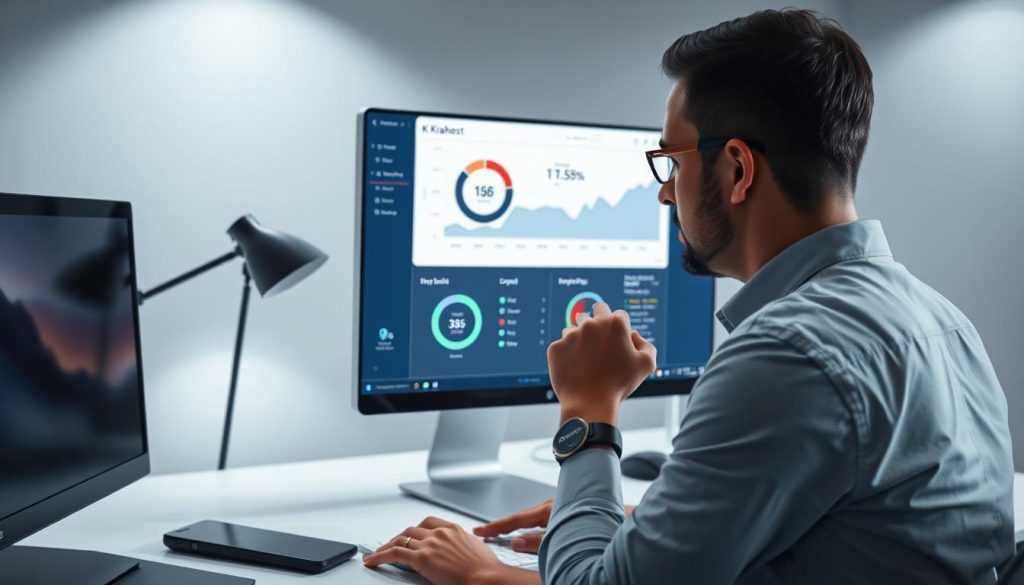
Website Speed Optimization: Improve Your Site’s Loading Time
Want to boost your online presence? A fast-loading site is key for a smooth user experience. In today’s fast-paced digital world, a slow site can cause visitors to leave quickly. This can harm your reputation online.
To keep visitors interested, your site needs to load fast. By optimizing your site’s performance, you make your users happy. For a strong start, get top-notch hosting and domain registration from Krahost.com.
Key Takeaways
- Enhance user experience with a fast-loading site
- Improve site performance to reduce bounce rates
- Invest in reliable hosting services for a solid online foundation
- Optimize your site for better engagement
- Consider domain registration with a reputable provider
Why Website Speed Matters for Your Online Success
Website speed is key for a good user experience, better search engine rankings, and higher conversion rates. A slow website can make users unhappy, leading to them leaving quickly and losing money.
The Impact of Loading Time on User Experience
A fast website is vital for a great user experience. Quick loading times keep users interested and exploring your site. But, a slow website can frustrate users and make them leave fast.
Key statistics on user experience and loading time:
| Loading Time | User Reaction |
|---|---|
| 0-3 seconds | Users are likely to stay engaged |
| 3-5 seconds | Users may start to get impatient |
| More than 5 seconds | High likelihood of users leaving the site |
How Speed Affects SEO Rankings
Website speed is also important for SEO. Search engines like Google look at page load times when ranking sites. A faster site can boost your rankings, bringing more visitors to your site.
Speed and Conversion Rates: The Direct Connection
A fast website can also boost your conversion rates. Quick loading times encourage users to take action, like buying or filling out forms. By speeding up your site, you can increase your sales and revenue.
For instance, a study found that a one-second delay in page load time can result in a 7% reduction in conversions.
Understanding Website Speed Metrics
To make your website faster, you first need to know what speed metrics are. It’s important to understand what you’re measuring and why it’s key.
Key Performance Indicators to Track
There are a few key performance indicators (KPIs) to check your website’s speed. These are First Contentful Paint (FCP), Time to Interactive (TTI), and Total Blocking Time (TBT). FCP shows when the first content is loaded, TTI tells you when the page is ready to use, and TBT shows how long the main thread is blocked.
Industry Benchmarks for Ghanaian Websites
For Ghanaian websites, it’s important to look at local internet speeds. Aim for an average load time of under 3 seconds, which is good worldwide. But, because of Ghana’s internet speeds, aiming for slightly longer times might be more realistic.
Setting Realistic Speed Goals
To set achievable speed goals, use tools like Google PageSpeed Insights to analyze your site. Find areas to improve and focus on the most impactful ones. This will help you make your website faster and better for users.
Essential Tools for Diagnosing Speed Issues
To make your website faster, you first need to find out what’s slowing it down. There are many great tools to help you figure out where to start. These tools can show you where your website needs a boost.
Google PageSpeed Insights
Google PageSpeed Insights checks how fast your website loads on both computers and phones. It gives you a score and tells you how to make it faster. To increase website loading speed, follow the tips it gives you.
GTmetrix and Pingdom
GTmetrix and Pingdom are well-known for their detailed speed reports. They look at things like how big your pages are and how long they take to load. These tools help you find out what’s making your site slow.
- GTmetrix shows a detailed chart of how your page loads.
- Pingdom gives you a score and tells you what to work on.
Browser Developer Tools
Most browsers have tools to help you find speed problems. The Network panel lets you see how long things take to load. This is super helpful for finding out what’s slowing your site down.
Interpreting Test Results
After using these tools, it’s important to understand what they say. Look for common advice like making images smaller or using browser caching. Focus on these first because they can make a big difference.

With these tools and a good understanding of their results, you can fix your website’s speed problems. This will make your site faster and improve how users experience it.
The Foundation of Website Speed Optimization
To make your website faster, start with the basics. This means looking at hosting and content delivery. You need to focus on key elements to optimize page load speed.
Choosing the Right Hosting Provider
Your hosting provider is key to your website’s speed. A good host with strong infrastructure can really enhance website speed. Look for a host with fast server response, high uptime, and the ability to grow with your site.
Why Krahost.com is Ideal for Ghanaian Websites
Krahost.com is a top choice for Ghanaian websites. It offers local services and infrastructure tailored for the region. Choosing Krahost.com means faster server times and better uptime, which are key for enhancing your website’s speed.
| Hosting Provider | Server Response Time | Uptime |
|---|---|---|
| Krahost.com | 50ms | 99.9% |
| Other Providers | 100ms – 500ms | 95% – 99% |
The Importance of a Content Delivery Network (CDN)
A CDN can make your website load much faster. It caches content at locations near your users. This optimizes page load speed and eases the load on your main server.
Domain Registration and DNS Configuration
Good domain registration and DNS setup are also essential. A reliable DNS service cuts down on latency. This means users can get to your site quickly.
By focusing on these basics and using services like Krahost.com, you can make your website much faster. This will improve your site’s overall performance.
Image Optimization Techniques for Faster Loading
Images can slow down your website, but there are ways to fix this. Making your images smaller is key to a faster site and better user experience.
To optimize your images, you need to know the best methods. First, pick the right image format for your needs.
Proper Image Formats and When to Use Them
Choosing the right image format can make your images smaller. JPEG is great for photos because it supports lots of colors. PNG is better for graphics and images that need to be transparent. WebP is a newer format that compresses images well but might not work on all browsers.
Compression Tools and Plugins
Compressing images makes them smaller without losing much quality. Tools like TinyPNG and ImageOptim work well. For WordPress users, plugins like WP Smush and Imagify can do the job automatically.
Implementing Lazy Loading
Lazy loading delays images until they’re needed. This makes your site load faster at first. You can use JavaScript libraries or plugins for your CMS to add lazy loading.
Responsive Images for Different Devices
Responsive images make sure your site shows the right image size for each device. You can use the srcset attribute in HTML or let your CMS handle it.
| Image Format | Use Case | Compression Level |
|---|---|---|
| JPEG | Photographs | High |
| PNG | Graphics, Transparent Images | Medium |
| WebP | Web Images, Animations | Very High |
Using these image optimization techniques can make your website load faster and improve user experience.
Optimizing Code to Speed Up Your Website
Improving your website’s code can make it load faster. By making your website’s structure more efficient, you can give users a better experience. There are several key techniques to focus on.
Minifying CSS, JavaScript, and HTML
Minification removes extra characters from your code, like spaces and comments. This makes your files smaller and faster to download. Tools like Gzip and CMS plugins can help with this. For example, minifying CSS and JavaScript can cut their size by up to 50%, speeding up your site.
Reducing HTTP Requests
Each time a user visits your site, their browser makes an HTTP request for each file. Cutting down on these requests can make your site faster. You can do this by combining CSS files, using CSS sprites, and enabling browser caching.
“Reducing HTTP requests is one of the most effective ways to improve website performance.”
Implementing Browser Caching
Browser caching stores often-used resources on the user’s browser. This way, when they return to your site, it loads faster from the cache. You can set cache-control headers to achieve this. For instance, set a long cache lifetime for static resources like images and CSS files.

Critical Rendering Path Optimization
The Critical Rendering Path is how the browser renders a web page. Optimizing this path means the browser can start rendering quickly. You can do this by inlining critical CSS, deferring non-critical JavaScript, and optimizing resource loading order. This can greatly improve your website’s loading time and user experience.
| Optimization Technique | Description | Impact on Loading Time |
|---|---|---|
| Minification | Removing unnecessary characters from code | Reduces file size, speeding up download times |
| Reducing HTTP Requests | Combining files and using CSS sprites | Decreases the number of requests, improving page load times |
| Browser Caching | Storing resources on the user’s browser | Reduces the need for repeat requests to the server |
| Critical Rendering Path Optimization | Optimizing the order and loading of resources | Enables the browser to render the page more quickly |
By using these code optimization techniques, you can make your website much faster. This leads to a better user experience and can even help your site rank higher in search engines.
Mobile Speed Optimization Strategies
Mobile speed optimization is now a must for websites aiming at Ghanaian users. With more people using mobile internet, a slow site can cause high bounce rates and missed chances.
Responsive Design Best Practices
Responsive design is key for a smooth mobile experience. It means:
- Flexible grids and layouts that fit all screen sizes
- Optimized images and media for different devices
- Content that’s easy to see on smaller screens
Accelerated Mobile Pages (AMP)
Accelerated Mobile Pages (AMP) helps make mobile web pages fast and light. Using AMP can greatly boost your site’s mobile speed.
Testing Mobile Performance
It’s important to test your site often to find ways to get better. Use tools like Google’s Mobile-Friendly Test and PageSpeed Insights to check your site’s mobile speed.
Optimizing for Ghana’s Mobile Networks
Ghana’s mobile networks have different speeds and reliabilities. To improve for these, consider:
- Compressing files to cut down on data transfer
- Using browser caching to lessen repeat requests
- Reducing HTTP requests to speed up loading
By using these strategies, you can make sure your site loads fast and smoothly for your Ghanaian visitors.
Advanced Website Speed Optimization Techniques
To make your website fast, you need to try advanced speed tricks. These methods are more than just basic tips. They help make your site load quicker and feel better to users.
Implementing GZIP Compression
GZIP compression makes your website’s files smaller, which speeds up loading. It works on files like HTML, CSS, and JavaScript. By using GZIP, you can cut file sizes by up to 70%. This means faster pages and happier users.
Database Optimization
For sites that change a lot, keeping the database in shape is key. A fast database means pages load quicker. Keeping your database clean and running smoothly is essential for a fast site.
Using Content Delivery Networks Effectively
CDNs spread your site’s content around the world. This cuts down the distance to your users. Using a CDN well means knowing where your visitors are and setting up caching right.
Server-Side Rendering vs. Client-Side Rendering
Choosing between SSR and CSR affects your site’s speed. SSR makes pages load faster on the first visit. CSR is quicker for follow-up visits.
“The key to optimal rendering is understanding your website’s needs and user behavior.”
With these advanced tips, you can make your website much faster. This will make your users happy and might even help your search rankings.
Common Speed Issues for Ghanaian Websites and How to Fix Them
If you own a website in Ghana, you might face certain speed problems. These issues often stem from internet infrastructure, bandwidth, and how content is delivered.
Dealing with Limited Bandwidth
Bandwidth is a big worry for Ghanaian websites. To increase website loading speed, make your content lighter. This means compressing files, using smaller image formats, and cutting down on heavy scripts.
Optimizing for Local Internet Infrastructure
Knowing Ghana’s internet setup is key to speeding up your site. Use local hosting and Content Delivery Networks (CDNs) with servers near your audience. This cuts down on delays and makes your site load faster.
Balancing Rich Content with Speed Requirements
Ghanaian sites often struggle to keep content rich and fast. Use lazy loading for images and videos. Also, make sure your site’s design is fast without hurting the user experience.
Local Hosting vs. International Hosting Considerations
Choosing between local and international hosting affects your site’s speed. Local hosting might be faster, but international hosting could be more reliable. Think about your audience and business goals when deciding.
| Hosting Type | Latency | Reliability | Cost |
|---|---|---|---|
| Local Hosting | Low | Medium | Moderate |
| International Hosting | Medium to High | High | Variable |
Conclusion: Maintaining Your Website’s Performance Long-Term
To keep your website running smoothly, regularly check its speed and performance. Make sure your hosting provider meets your needs. Also, use a content delivery network (CDN) to cut down on latency.
For websites in Ghana, it’s key to balance rich content with speed. By following the strategies in this article, you can make your site load faster. This will greatly improve your users’ experience.
To boost your website’s performance even more, look into the best hosting services and domain registration at Krahost.com. Their reliable services can help keep your site fast and efficient. This will lead to more conversions and better online success.